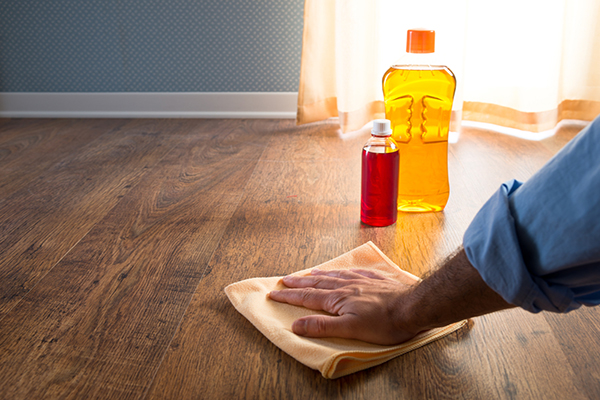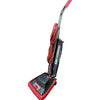
Unfinished Wood Floors: How to Clean them and How Not to
The Biggest Cleaning Mistakes You Can Make on Your Unfinished Wood Floors
Although ignorance has oftentimes been a source of bliss, in the case of cleaning unfinished wooden floors, it can be a source of great frustration and foolish loss. Don’t make the mistake of assuming that just because you know how to clean hardwood floors that are treated, you know how to clean untreated wooden floorboards. In order to preserve your floors, here are some cleaning mistakes you should never commit.
1. Cleaning untreated floors with water and a mop.
This traditional method of cleaning may be reliable for a lot of other things, but on unfinished floors, it’s a problem. Water on your floor can cause warping and damage. Whatever you do, don’t attempt to clean this type of flooring with wet cleaning methods like this. It’s a bad idea.
2. Using products for finished floors on unfinished floors.
Read the labels. Unless a product says it is specifically designed to clean untreated floors, it is more likely that it isn’t safe to clean unsealed wood floors. Using the wrong products on your unfinished flooring has a huge chance of permanently staining your untreated wood for life.
3. Scrubbing with hard, wet bristled brushes or cleaning pads.
As unfinished floors are not yet treated for the environmental wear, and tear of modern-day living, they are very susceptible to damage, erosion, and deformation. No matter how much dirt and grime you’re trying to clean, digging into your floors with a hard, bristled object may actually result in you carving and shaving it up. In other words, you damage the wood.
The Best Way to Clean Your Wooden Floor When It’s Unfinished
Now that you know what you should never do to clean an unfinished hardwood floor, it’s time to learn what you should do to get the best cleaning job done.
1. Get rid of as much dust, dirt and debris as you can
What you will need:
– A broom and scoop, OR a static dust mop, OR a hard floor vacuum cleaner
There are two main ways you can do this. The first is you can use a broom and scoop or a static dust mop. These manual methods of cleaning are effective but take a bit more patience and mindfulness than the second method.
The second method to get rid of the dust and debris is to use a vacuum cleaner, but, be warned. The vacuum cleaner needs to have a dedicated hard floor setting. If not, the beater bar/brush roll can potentially cause some serious permanent damage to your untreated wood floor.
2. Remove any unsightly or undesirable stains
What you will need:
– Trisodium Phosphate
– Soft-bristled scrubbing brush OR microfiber cloth
Since untreated wood is very absorbent, it is easily stained. That’s why, prior to disinfecting it, you’ll want to take a moment to remove those stains and dry your floors properly. To remove stains from unfinished wood, pour a small amount of trisodium phosphate on the stained area. Use the soft-bristled brush to gently scrub the area. Although using water is otherwise highly advised against, in this case, you must rinse the spot clean with a bucket of water once the stain is removed. Immediately wipe the wet area afterward with a dry cloth, soaking up as much of the moisture as possible. Try your best to pick up every bit of moisture, and not to leave any behind, as that will cause the wood to become warped and, ultimately, destroyed.
3. Clean and disinfect it
What you will need:
– Mineral spirits
– Protective gear like gloves, paint mask/respirator, eye protection
– A non-abrasive, clean white rag/non-colored cloth
– Spray bottle (optional)
Also known as paint thinner, mineral spirits have been used as a disinfectant for untreated wood for a very long time. However, as this chemical is quite toxic, it is recommended that you use protective gear to work with it, especially during your first few times. Mineral spirits have the tendency to make you lightheaded and can cause major irritation if it comes into contact with your skin. If it does get on your skin, wash immediately with soap and water. If you become nauseous or dizzy, leave the area completely. The best way to use mineral spirits is in a well-ventilated setting.
There are two ways to use mineral spirits. One way is to dampen a clean cloth with the liquid and rub it into the floor. You can also use the optional method of spraying the mineral spirits directly onto the floor with a spray bottle, and then rubbing it with the cloth. Spraying it helps to get more even coverage for the purpose of disinfecting and cleaning. Any remaining stains should disappear with the use of this substance.
When done, be sure to wipe off any excess with another clean, dry cloth. Then, let the area dry naturally, keeping the room and well-ventilated as possible.
ALTERNATIVE: A Vinegar Solution
For those who have no interest in using harsh and intense chemicals to clean their untreated floors, there is a more natural option that is actually one of the safest and cheapest methods available. This can serve as a replacement for using mineral spirits: vinegar.
What you will need:
– Vinegar solution: ½ cup vinegar per gallon of water
– Clean mop
Fill a bucket with the vinegar and water solution. Dip the clean mop into the bucket and wring it out. Then use that to mop up the floor and stains, much like the way you would with the mineral spirits. In fact, you can use the spray bottle method like you would with the mineral spirits if that suits your cleaning style better. If the water becomes too murky or dirty during the cleaning process, change it. When mopping, if you mop in the direction along the grain of the wood, it will mask any streaky lines that result from the process.
If you’re one of those people who really can’t stand the smell of vinegar, you can make the solution more tolerable by adding about 15 drops of your favorite essential oil We recommend lavender, pine, or lemon. Make sure any excess solution is mopped up, and that you’ve removed as much of the moisture as you can.
Keep your kids, pets, and guests off the floor until it is completely dry, smudge-free.
Final Thoughts On Cleaning Unfinished Wood Floors
These are some of the best tips for cleaning unfinished wood, but there are even more alternatives available, like Murphy’s Oil Soap or olive oil. In the event you have ridiculously tough stains that just won’t come out, you might have to look into sanding the stains away. If you don’t know how to handle a sanding machine and the job can’t be done effectively or neatly with some sandpaper, it would probably be in your best interest to hire a professional to take care of it for you.
Either way, when trying something new to clean unfinished wood floors, make sure you can safely clean with whatever cleaning products you choose. You can do this by testing a small section of your floor using a white rag to dab some of your chemicals down and see how the wood handles it.
Taking care of an untreated floor is much more tedious work than caring for various other floor types. However, the result is always worthwhile if you do a good job at it. Even if you intend to one day treat and finish your wood floors, ideally, you should try to give it a thorough cleaning at least once every two months.
- 24 Mar, 2022



































